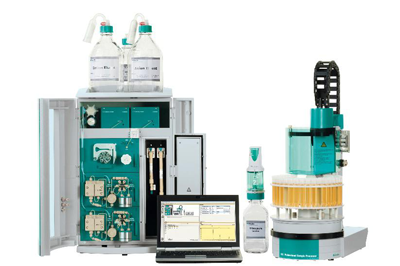What Is an Ion Chromatograph?

An ion chromatograph, a type of liquid chromatography, is a separation analysis method mainly focused on the analysis of low-molecular-weight ions.
The pioneering work on ion chromatography dates back to 1975 when H. Small published the paper “Novel Ion Exchange Chromatographic Method Using Conductivity Detection” in the Analytical Chemistry journal. H. Small and his colleagues separated ions using ion exchange resins and detected them with a conductivity detector.
What Can Be Measured with Ion Chromatography?
While ion chromatography can measure various ions, its unparalleled field lies in the simultaneous analysis of anions. Halide ions (F-, Cl-, Br-), NO2-, NO3-, SO42-, PO43-, and others can be measured at ppb (μg/L) levels. Moreover, by selecting specific measurement conditions, simultaneous analysis of polyatomic oxyacids ions like ClO2-, ClO3-, BrO3-, and others is also achievable. It is estimated that 70% of IC users perform analysis of these anions.
In cation analysis, alkali metal ions such as Li+, Na+, K+, and alkaline earth metal ions like Mg2+, Ca2+, Ba2+ can be measured.
Organic ions can also be measured. Low-molecular-weight aliphatic amines such as methylamine, dimethylamine, ethylamine, and ethanolamine can be measured using the same cation exchange separation and conductivity detection as alkali metal ions. Additionally, aliphatic organic acids like formic acid, acetic acid, propionic acid, lactic acid, tartaric acid, malic acid, and citric acid can be measured in ion exclusion mode.
Principles of Ion Chromatography
The mobile phase (eluent [Na2CO3]) is pumped through the chromatograph, and the sample solution (a solution containing NaCl) is introduced in a fixed amount from the injector (sample introduction device) and sent to the column.
The column is filled with anion exchange resin, and ion separation occurs through ion exchange interactions. Subsequently, counter ions (Na+) in the mobile phase are removed by the suppressor, and Na2CO3 is converted to weakly ionized H2CO3, resulting in lower electrical conductivity.
Simultaneously, counter ions of the sample, NaCl, are also ion-exchanged, transforming into highly conductive HCl.
The suppressor has two functions: ① reducing the electrical conductivity of the mobile phase and ② increasing the electrical conductivity of the target ions.
The conductivity detector examines the ease with which electricity passes through the solution. The signal from the conductivity detector is sent to the data processing device, and a waveform (chromatogram) corresponding to ion concentration is drawn.
By observing the time elapsed from sample injection to peak appearance (retention time, elution time), you can determine qualitatively what ions are present. The peak height (or area) allows quantitative measurement of the concentration.
Uses of Ion Chromatography
Ion chromatography is particularly powerful for measuring ions in water samples, and as a result, it is widely adopted in various official test methods for industrial water testing, factory wastewater testing, drinking water testing methods, sewage testing methods, and sanitary testing methods.
Therefore, its predominant use is in fields related to the environment, water supply and sewerage, wastewater, and it is extensively employed by many public testing agencies and contract analysis companies.
Furthermore, due to its capability to measure inorganic ions at the ppt (ng/L) level, ion chromatography is used in water quality analysis for semiconductors, ultrapure water, and nuclear-related applications.
Beyond water samples, ion chromatography can be utilized for ion measurement in extraction solutions, absorption solutions, and can even measure ions in solids and gases.
IC extends beyond water quality and environmental applications; it is used in various fields such as food, chemistry, and pharmaceuticals for raw material management, process control, product management, quality inspection, and more.